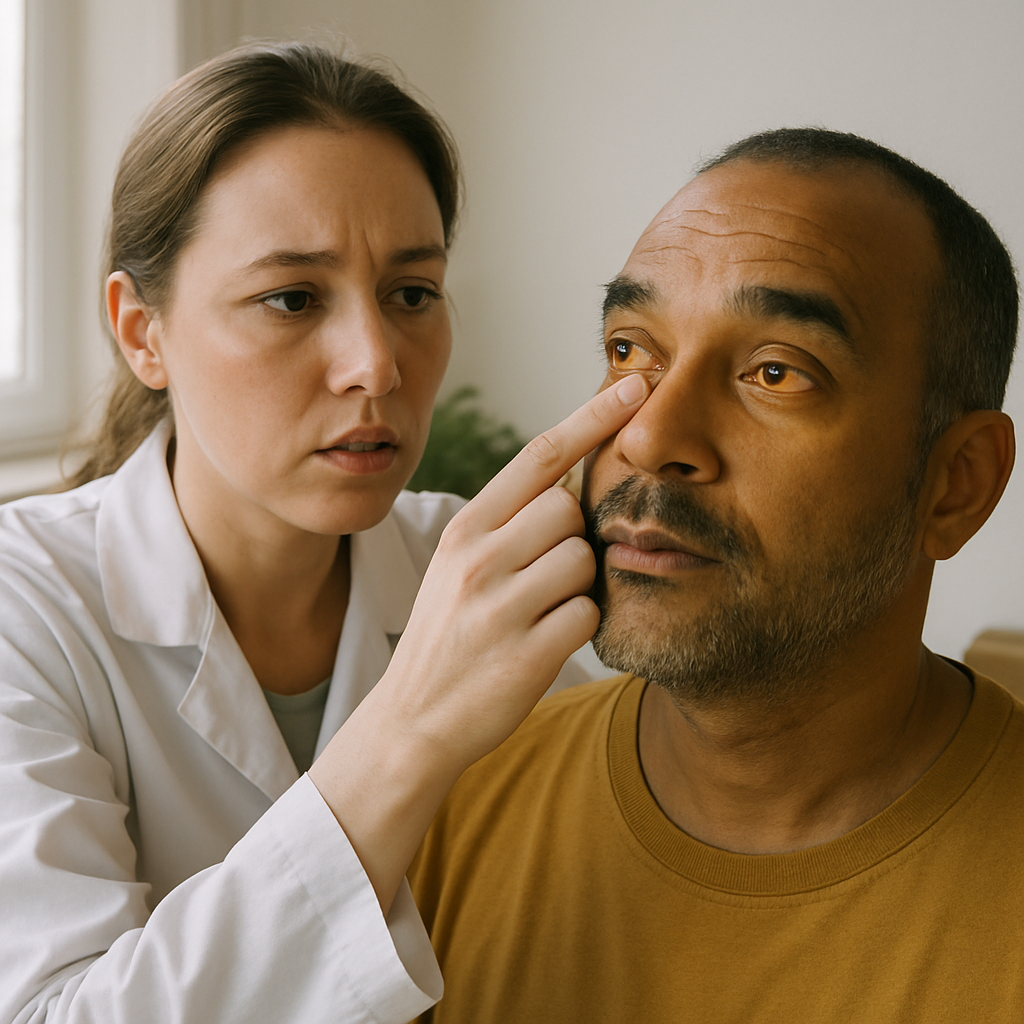Shop Now in Our Store
How to Check Jaundice at Home: Symptoms and Signs in Adults and Newborns

Jaundice isn’t just something you hear about in medical dramas—it’s a real condition that can affect both adults and newborns. Whether you're trying to figure out how to check jaundice at home or just worried about a loved one's yellowish skin tone, you're not alone. This article covers everything from the symptoms of jaundice to how you can spot it yourself before rushing to a doctor.
We’ll walk you through the signs of jaundice in adults and babies, talk about the starting symptoms of jaundice, and help you decide whether a professional jaundice test is necessary. By the end, you’ll know how to check jaundice, why it happens, and when it’s time to take things seriously.
Let’s break it down in a clear, human way—without the medical jargon overload.

What Is Jaundice and Why It Happens
Jaundice is a condition where your skin, the whites of your eyes, and even your gums can turn a yellowish color. Sounds scary, yeah? But it’s actually caused by an excess of bilirubin—a yellow pigment that forms when red blood cells break down.
Normally, the liver filters out bilirubin. But if your liver isn’t working properly or there's too much bilirubin to handle, it starts building up in your body. That’s when the yellowing kicks in.
Jaundice Causes in Adults and Newborns
In adults, causes of jaundice can range from serious stuff like hepatitis or liver disease to less dramatic issues like gallstones or alcohol-related damage.
For newborns, it’s a little different. Jaundice in newborn babies is actually quite common and usually not a cause for panic. Their livers are still getting used to the outside world and might not clear out bilirubin fast enough.
Other causes of jaundice in adults include:
-
Cirrhosis (scarring of the liver)
-
Infections like mononucleosis
-
Certain medications
-
Genetic liver conditions
-
Pancreatic cancer (rare but serious)
In newborns, the causes might include:
-
Premature birth
-
Blood type mismatch with the mother
-
Breastfeeding issues
-
Internal bleeding (rare, but it happens)

Symptoms of Jaundice in Adults and Newborns
So how do you actually know if it’s jaundice? It’s not always just “yellow skin”—there’s more to it.
Early Symptoms of Jaundice in Adults
The early symptoms of jaundice in adults can be sneaky. You might notice:
-
Fatigue (like, way more than usual)
-
Itchy skin with no clear reason
-
Dark urine (yes, even if you're hydrated)
-
Pale stool
-
Yellowing in the eyes before the skin
These jaundice symptoms in adults might show up gradually, and sometimes they’re mistaken for just being tired or under the weather. That’s why it’s key to pay attention.
Jaundice Symptoms in Newborns to Look For
With jaundice in newborns, signs often appear 2 to 4 days after birth. Look out for:
-
Yellow skin starting on the face and moving down the body
-
Sleepiness or sluggishness during feeding
-
Difficulty waking up for feeding
-
High-pitched crying (sometimes!)
-
Poor weight gain
You can gently press on your baby’s forehead or nose—if the skin looks yellow when you lift your finger, that’s a possible indicator.
How to Check Jaundice at Home
So, let’s talk about the practical stuff. You don’t need fancy equipment to check jaundice at home—just a good eye, a bit of light, and some awareness of what to look for. Whether you're trying to monitor symptoms of jaundice in adults or check your newborn for yellowing, here’s how to do it safely and effectively.
How to Check Jaundice at Home for Adults
First things first, lighting matters. Natural daylight is best, so head to a bright room or near a window. Now here’s what you do:
-
Look at the eyes. The whites (sclera) are usually the first place jaundice shows up. A yellow tint here is a major clue.
-
Check the skin tone. Especially around the face, chest, and hands. Press lightly on the skin and release—if the area appears yellowish, that’s a red flag.
-
Watch for dark urine. If your urine suddenly turns dark brownish or tea-colored and you're not dehydrated, that could mean high bilirubin.
-
Notice fatigue and itching. These aren’t visual, but they can be starting symptoms of jaundice. If you’re also yellowing, it’s probably time to call a doc.
How to check jaundice at home for adults doesn’t replace professional tests, but it’s a solid first step. And no, your phone flashlight won’t cut it—stick to natural light.
Also, keep in mind that darker skin tones can make it harder to see yellowing on the skin, so the eyes and gums are even more important to check.
How to Check Jaundice in Newborn
How to check jaundice in newborn babies is similar but with extra care. Their skin is more delicate and signs show up fast.
Here’s how to check:
-
Natural light again. Never try to check under colored light or in dim rooms—it’ll totally mess with what you see.
-
Press gently on the skin. Start at the forehead or nose. If the skin looks yellow when you release your finger, that’s a possible sign.
-
Work your way down. Jaundice usually starts at the face and moves to the chest, arms, legs. If it’s below the belly button, it could be more severe.
-
Monitor behavior. If the baby’s super sleepy, not feeding well, or seems weak, that might be tied to jaundice—especially in the first week of life.
You should also keep an eye out for yellowing in the whites of their eyes. It’s not always obvious, but it’s a solid clue.
Now, this might sound basic, but parents often miss the early stages because the lighting in hospitals or homes isn’t always ideal. Trust your gut—if something feels off, better safe than sorry.
When to Do a Jaundice Test at Home or Seek Help
Okay, so you've spotted the signs. Maybe the whites of your eyes are looking a bit yellow or your baby’s skin seems off. What now?
When to Confirm with a Lab Jaundice Test
If you're seeing multiple signs—yellowing skin, dark urine, pale stools, or fatigue—it's probably time to do more than just look in the mirror. A lab jaundice test is the only way to confirm how much bilirubin is in the blood.
Here’s when to seek professional help:
-
Yellowing spreads or intensifies over a few days
-
Symptoms don’t improve with rest or hydration
-
You or your baby have a fever, vomiting, or show signs of infection
-
Newborn jaundice shows up before 24 hours old (this can be serious)
-
Your baby becomes very sleepy, won’t feed, or cries in a high-pitched tone
-
In adults, jaundice is paired with sudden weight loss or abdominal pain
A doctor might order a blood test, liver panel, or even imaging depending on the situation. Don't worry—it sounds scarier than it is. The important thing is catching it early.
Conclusion
Jaundice isn’t always a medical emergency, but ignoring it? Not the smartest move. Whether you’re an anxious parent checking how to check jaundice in newborn babies or you're dealing with unexplained fatigue and yellowing skin yourself, understanding the symptoms of jaundice and knowing how to check jaundice at home can make all the difference.
Remember:
-
Jaundice causes can vary, especially between adults and newborns
-
Knowing the starting symptoms of jaundice helps with early detection
-
Home checks aren’t a replacement for a real jaundice test but are still incredibly helpful
-
Don’t wait if things feel “off.” Especially with newborns—timing is everything
Catching it early can mean quicker treatment, better outcomes, and peace of mind. If there’s one thing to take away from this, it's this: trust your instincts and don’t brush off the yellow flags—literally.
FAQs
How to check for jaundice in newborns at home?
Use natural daylight. Gently press on the baby’s forehead or chest—if the skin looks yellow when you release, it could be jaundice. Check the whites of the eyes too. If symptoms spread or worsen, consult a doctor immediately.
Can jaundice go away on its own?
Sometimes, yes. Mild jaundice in newborns often clears up in a week or two. In adults, it depends on the cause. If it's due to a temporary issue like a virus, it may resolve on its own. But always get checked—better safe than sorry.
What causes jaundice in adults and infants?
In adults, jaundice causes include liver diseases (like hepatitis or cirrhosis), gallstones, or medications. For infants, it’s usually immature liver function, especially in preemies or babies with blood-type mismatches.
Final Tip: If this article helped you, share it with someone who might need it. Knowledge saves lives—and sometimes it starts with just knowing how to check jaundice at home.
This article is checked by the current qualified Dr Sujal Patil and can be considered a reliable source of information for users of the site.
Got any more questions?
Ask Ayurvedic doctor a question and get a consultation online on the problem of your concern in a free or paid mode.
More than 2,000 experienced doctors work and wait for your questions on our site and help users to solve their health problems every day.

